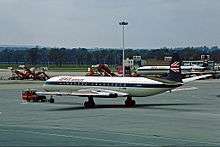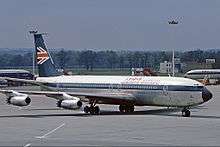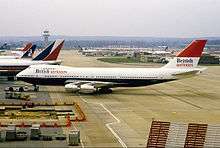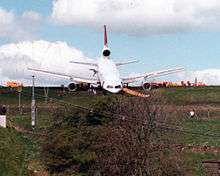British Airtours
|
| |||||||
| |||||||
| Founded | 1969 (as BEA Airtours) | ||||||
|---|---|---|---|---|---|---|---|
| Ceased operations | 1988 (renamed Caledonian Airways) | ||||||
| Hubs | |||||||
| Fleet size | 10 | ||||||
| Destinations | worldwide | ||||||
| Headquarters |
Gatwick Airport (administrative HQ, 1970—1988) Ruislip, London Borough of Hillingdon (corporate HQ, 1969—1973) London Heathrow Airport (corporate HQ, 1974—1988) Lowfield Heath, Crawley, West Sussex (combined HQ, 1988—1999) | ||||||
| Key people |
P.C.F. Lawton, Eamonn Mullaney, Capt. W. Baillie, George Blundell-Pound, E.L. Killip, J.R. Wood, Capt. P.J. McKeown, R.A. Thorburn, W.A. Thompson, J. Marshall | ||||||
British Airtours was a British charter airline with flight operations out of London Gatwick and Manchester Airport.
Originally established as BEA Airtours in 1969, it became a wholly owned subsidiary of then state-owned British Airways (BA) following the British European Airways (BEA) — British Overseas Airways Corporation (BOAC) merger of the early 1970s. British Airtours adopted the Caledonian Airways name when the newly privatised British Airways completed the acquisition of the rival British Caledonian (BCal) in April 1988. Caledonian Airways was eventually sold to UK tour operator Inspirations in 1995, marking BA's exit from the mainstream inclusive tour (IT) market. In 1999, Thomas Cook acquired Inspirations and merged Caledonian Airways with Flying Colours to form JMC Air Services, a forerunner of the UK arm of the present day Thomas Cook Airlines.
History
BEA Airtours was formed on 24 April 1969 as a division of BEA to provide it with a low cost platform to participate in the then rapidly growing inclusive tour (IT) holiday flights market, which until then had been the exclusive domain of wholly privately owned airlines independent from the government-owned corporation BEA and BOAC. BEA saw this as a necessary counterweight to the independents' rapidly growing scheduled activities that began encroaching on what BEA and BOAC had traditionally regarded as their sole preserve.[1] BEA Airtours' formation was in line with one of the recommendations of the Edwards Report on the future of British air industry - that the corporations should enter the inclusive tour and charter market.[2][3][4]
The independent charter airlines were suspicious of BEA's motive to enter the IT market and thought that there was a hidden agenda to destabilise this market by undercutting the independent carriers, none of which could match the corporation's financial resources and access to capital at the time. The independents moreover thought that BEA Airtours was meant to take on the corporations' excess staff as well as to absorb aircraft that were surplus to their requirements. They feared that this would lead to significant market distortions, creating excess capacity and further depressing the already low charter rates in a highly competitive market.[5]
Commercial airline operations commenced from London Gatwick in 1970 with a fleet of seven second-hand ex-BEA de Havilland Comet series 4B aircraft seating 109 passengers in a single-class configuration.[1][6][7] The first revenue flight departed Gatwick on 6 March 1970.[8]
In 1971, BEA Airtours had decided to replace the entire fleet with a similar number of larger capacity, longer range and more fuel-efficient ex-American Airlines Boeing 707-123Bs[9][10] to enable it to commence non-stop, long-haul charter flights, including "affinity group" charters to North America.[11][12] Despite having obtained permission from the UK's Department of Trade and Industry to import second-hand 707-120Bs and the non-availability of "internally sourced" alternatives (BOAC's 707-436s) within the envisaged timeframe,[9] both corporations opposed this decision. They insisted that any new aircraft should be exclusively sourced from the existing BEA and BOAC fleets.
Following the corporations' intervention, BEA Airtours acquired seven former BOAC Boeing 707-436s.[11][12][13][14][15] These aircraft had a greater seating capacity than required and were powered by four Rolls-Royce Conway engines, an older generation engine type than the four Pratt and Whitney JT3D turbofans which powered the ex-American 707-123Bs it had originally selected to replace its Comet fleet. This meant that the ex-BOAC 707s had higher operating costs. However, BOAC was prepared to sell these aircraft to BEA Airtours at a lower price than American was asking for its planes. The £4.3m sale price included BOAC's entire spares holding (inclusive of engines) for the seven aircraft.[16] This helped compensate for the cost differential. The first of these 174-seat aircraft entered service in 1971 while the last aircraft of this batch joined the fleet in 1973.[15] By that time, four of the airline's nine Comet 4Bs had already been withdrawn from service and sold to rival UK charter airlines.[12]
The 1973 oil crisis in the wake of the 1973 Arab-Israeli War, which led to a quadrupling of the price of a barrel of oil, substantially increased the operating costs of the remaining fuel-thirsty Comets and began to have an adverse impact on the airline's financial performance.
British Airtours, as the airline had become known following the creation of British Airways in 1974 as a result of the 1972 BEA—BOAC merger, therefore decided to retire its remaining five Comets at the end of that year's summer season and to sell the entire fleet to Dan-Air.[12][17][18]
In 1975, British Airtours commenced transatlantic Advance Booking Charter (ABC) flights to the United States.
Over the coming years, British Airtours acquired additional Boeing 707s British Airways had inherited from BOAC.
When British Airways decided in the late-1970s to replace the aging and increasingly inefficient short-/medium-haul Hawker Siddeley Tridents and BAC One-Elevens it had inherited from BEA with state-of-the-art Boeing 757s and 737s, a follow-on order for nine brand-new 737-236 Advanced aircraft was placed with Boeing.[19] These aircraft, which were delivered to British Airtours' Gatwick base during the early 1980s,[20] allowed it to replace all of its old, second-hand narrowbodied planes with brand-new equipment, thereby considerably enhancing its competitiveness vis-à-vis its independent rivals.
In late-June 1982, British Airtours launched twice-weekly scheduled services between Gatwick and Newark using Boeing 707s in an all-economy configuration. However, the airline's foray into the transatlantic scheduled market ended after only seven months in early January 1983.[21][22]
In 1984, British Airtours took delivery of a Rolls-Royce RB211-powered Boeing 747-236B "jumbo" at Gatwick, its first and only brand-new widebodied aircraft. This aircraft was put into service on the airline's popular, long-haul ABC flights to North America.[23] The same year, British Airtours' last Boeing 707 made its final revenue flight.[24]
In the meantime, British Airtours also began taking delivery of a small number of former British Airways Lockheed L-1011 Tristar widebodies, which initially supplemented its narrowbodied 737 fleet on the busier and more popular routes.
In 1985, British Airtours introduced a new livery that closely resembled the one used by British Airways at the time (designed by Landor Associates).[25]
British Airtours adopted the popular Caledonian Airways brand in April 1988 when the newly privatised British Airways had completed the takeover of its former Gatwick-based rival British Caledonian. It also adopted a modified BCal livery adapted from the contemporary, Landor Associates designed British Airways livery.[26] The newly renamed Caledonian Airways moved its Gatwick operation from the airport's South Terminal into the then brand-new North Terminal, thereby concentrating most of the British Airways group's Gatwick services in the new terminal.[27]
Caledonian Airways began replacing its Boeing 737 narrowbodies with additional ex-British Airways L-1011 Tristar widebodies as well as with a number of brand-new Boeing 757s sourced from the large 757 orders placed by its parent company. The former British Airtours 737s were re-configured in British Airways' contemporary short-haul two-class cabin arrangement and began replacing the BAC One-Eleven 500s British Airways had inherited from British Caledonian on the UK flag carrier's short-haul Gatwick routes.
In 1995, British Airways decided to exit the short- to medium-haul package holiday market and sold Caledonian Airways to UK-based tour operator Inspirations, then part of the US-owned Carlson group, along with its core fleet of five Tristars. Following Caledonian's sale to Inspirations, the 757s were returned to British Airways.
Inspirations became part of the Thomas Cook group in 1999 when Caledonian Airways was merged with the Flying Colours airline to form JMC Air Services, which in turn became the UK arm of the present day Thomas Cook Airlines.
Following Inspirations' takeover by Thomas Cook, the former Caledonian Airways Tristars were withdrawn from service as these had suffered increasing, widely publicised reliability problems resulting in the travelling public's generally poor perception of Caledonian.
Aircraft operated

BEA "Speedjack"-derived livery, seen at London Gatwick Airport in May 1973.





Throughout its 29-year existence the following aircraft types formed part of the BEA Airtours/British Airtours/Caledonian fleet:
- Airbus A320-200 (Caledonian)
- Boeing 707-336B/C (British Airtours)/436 (BEA Airtours/British Airtours)
- Boeing 737-236 Advanced (British Airtours/Caledonian)
- Boeing 747-236B (British Airtours)
- Boeing 757-236 (Caledonian)
- de Havilland Comet 4B (BEA Airtours)
- Lockheed L-1011 Tristar 1/50/100/200 (British Airtours/Caledonian)
- McDonnell-Douglas DC-10-30 (Caledonian).
Fleet details
Fleet in 1970
In March 1970, the BEA Airtours fleet comprised 9 aircraft.[28]
| Aircraft | Total |
|---|---|
| de Havilland Comet 4B | 9 |
| Total | 9 |
Fleet in 1972
In May 1972, the BEA Airtours fleet comprised 11 aircraft.[29]
| Aircraft | Total |
|---|---|
| Boeing 707-436 | 2 |
| de Havilland Comet 4B | 9 |
| Total | 11 |
Five Boeing 707-436 were on order.
Fleet in 1974
In March 1974, the British Airtours fleet comprised 9 aircraft.[30]
| Aircraft | Total |
|---|---|
| Boeing 707-436 | 9 |
| Total | 9 |
Fleet in 1982
In April 1982, the British Airtours fleet comprised 9 aircraft.[31]
| Aircraft | Total |
|---|---|
| Boeing 737-236 Advanced | 9 |
| Total | 9 |
Fleet in 1984
In March 1984, the British Airtours fleet comprised 16 aircraft.[23][24][32]
| Aircraft | Total |
|---|---|
| Boeing 747-236B | 1 |
| Lockheed L-1011 Tristar 200/200F | 2 |
| Lockheed L-1011 Tristar 1 | 3 |
| Boeing 707-336B | 1 |
| Boeing 737-200 Advanced | 9 |
| Total | 16 |
Fleet in 1988
In March 1988, the British Airtours fleet comprised 10 aircraft.[32]
| Aircraft | Total |
|---|---|
| Lockheed L-1011 Tristar 100 | 1 |
| Lockheed L-1011 Tristar 1 | 3 |
| Boeing 737-200 Advanced | 6 |
| Total | 10 |
Incidents and accidents

- On 27 May 1985, a Lockheed TriStar (registration: G-BBAI) overran the runway at Leeds/Bradford Airport on landing from Palma after a rain shower. The aircraft was evacuated, with only minor injuries sustained by the 14 crew and 398 passengers. The nose landing gear strut folded backwards during the overrun, leading to severe damage to the underside of the forward fuselage. The undersides of both wing-mounted engines were flattened and both engines suffered ingestion damage. The main wheels of the aircraft also dug deep troughs in the area beyond the end of the runway, damaging the buried airfield lighting cables. The accident report concluded that the overrun was caused by the inability of the aircraft to achieve the appropriate level of braking effectiveness, and recommended that both the scheduled wet runway performance of the Lockheed L-1011 TriStar and the condition of the surface of runway 14 at Leeds/Bradford Airport should be re-examined.
- On 22 August 1985, British Airtours Flight 28M caught fire after an aborted take off at Manchester Airport while on a charter flight to the Greek island of Corfu. The fuel access panel on the aircraft's fuselage was pierced by a part of the compressor that had been ejected from the port engine as a result of a malfunction. The fire quickly engulfed the area around the rear of the plane filling the cabin with toxic fumes. Fifty-three passengers and two crew members died as a result - most of them dying of asphyxiation after inhaling the fumes.
References
- Citations
- 1 2 "BEA Names Charter Company", Flight International, 17 April 1969, p. 612
- ↑ First thoughts on Edwards", Flight International, 8 May 1969, p. 741
- ↑ The Edwards Report — Principal recommendations, Air Transport, Flight International, 8 May 1969, p. 745
- ↑ Airliner Classics (1960s: BEA Airtours Division Created), Key Publishing, Stamford, UK, November 2011, p. 9
- ↑ Plea for a better deal — Independent airlines lobby the opposition, Air Transport, 5 March 1970, p. 323
- ↑ Sensor — BEA Airtours ..., World News, Flight International, 4 September 1969, p. 343
- ↑ Air Transport, Flight International, 26 March 1970, p. 453
- ↑ World Airlines, Flight International, 6 May 1971, p. 619
- 1 2 Airtours 707s: February decision, Air Transport, Flight International, 14 January 1971, p. 45
- ↑ BEA Airtours ..., Air Transport, Flight International, 6 January 1972, p. 9
- 1 2 Airtours expansion, Air Transport, Flight International, 20 January 1972, p. 85
- 1 2 3 4 BEA Airtours profit growth, Air Transport, Flight International, 6 September 1973, p. 397
- ↑ Airtours buys BOAC 707s, Flight International, 1 July 1971, p. 2
- ↑ Airtours shops at home, Air Transport ..., Flight International, 8 July 1971, pp. 44/5
- 1 2 Air Transport, Flight International, 23 December 1971, p. 997
- ↑ Airways — B.O.A.C.'s Rolls-Royce Boeing 707s (Second-tier operations), Vol. 17, No. 2, Iss. 170, p. 44, HPC Publishing, St Leonards-on-Sea, April 2010
- ↑ Last Comet Tango, Air Transport, Flight International, 8 November 1973, p. 773
- ↑ Airliner World (The Last of Dan-Air's Comets – Additional Comets), Key Publishing, Stamford, UK, November 2010, pp. 71/2
- ↑ ... 737s for British Airtours, World News, Flight International, 30 December 1978, p. 2298
- ↑ Air Transport, Flight International, 12 April 1980, p. 1121
- ↑ BAT and Air Florida vie for London—Newark, World news, Flight International, 24 April 1982, p. 1026
- ↑ BAT ends Newark service, Air Transport, Flight International, 11 December 1982, p. 1661
- 1 2 Air Transport, Flight International, 31 March 1984, p. 794
- 1 2 Air Transport, Flight International, 17 March 1984, p. 665
- ↑ Airtours wears new colours, Air Transport, Flight International, 9 February 1985, p. 6
- ↑ The lion stays, Air Transport, Flight International, 12 March 1988, p. 5
- ↑ BA pulls out of Gatwick South, Flight International, 16 July 1988, p. 12
- ↑ World Airlines 1970 ..., Flight International, 26 March 1970, p. 474
- ↑ World Airlines — Supplement, Flight International, 18 May 1972, p. 16
- ↑ World Airline Directory, Flight International, 21 March 1974, p. 25
- ↑ World Airline Directory, Flight International, 3 April 1982, p. 826
- 1 2 airfleets — British Airtours, Airfleets.net, 2002-2009
- Bibliography
- "Flight International". Sutton, UK: Reed Business Information. ISSN 0015-3710. (various issues relating to BEA/British Airtours, 1969–1988)
- British Airways Archives and Museum Collection (1969–1995)
- "Aircraft (Gone but not forgotten: British Airtours)". Hersham, UK: Ian Allen Publishing. August 2011: 74–77. ISSN 2041-2150. (Aircraft online)
External links
![]() Media related to British Airtours at Wikimedia Commons
Media related to British Airtours at Wikimedia Commons